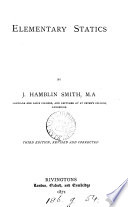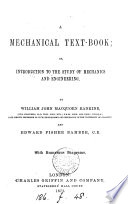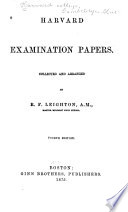 | Richard Wormell - Mechanics - 1869 - 270 pages
...25. When three forces acting on a particle can be represented in magnitude and direction by the three sides of a triangle taken in order, they will be in equilibrium. Let MAC (Fig. 20) be the tri- м^ angle ; complete the parallelogram м А с в, then the force represented... | |
 | J W. Mulcaster - 1871 - 242 pages
...37. Triangle of Forces.—If three forces acting at a point be represented in magnitude and direction by the sides of a triangle taken in order, they will be in equilibrium. Let AD, DC, CA represent three forces acting on a point A, suppose. Complete the parallelogram BD,... | |
 | James Hamblin Smith - Statics - 1871 - 148 pages
...TRIANGLE OF FORCES. If three forces, acting at a point, can be represented in magnitude and direction by the sides of a triangle, taken in order, they will be in equilibrium. Let AB, BC, CA, the sides of the triangle ABC, taken in order, represent in magnitude and direction... | |
 | William John Macquorn Rankine - Mechanical engineering - 1872 - 714 pages
...One Point. 51. Parallelogram of Forces. — THEOREM. Iftwoforces whose lines of action traverse one point be represented in direction and magnitude by the sides of a parallelogram, their resultant is represented by the diagonal. Vint i), i!i«..i-«iaii«i.. — Through... | |
 | William John Macquorn Rankine - Mechanical engineering - 1873 - 356 pages
...which the whole science of statics may be deduced. If two forces whose lines of action traverse one point be represented in direction and magnitude by the sides of a parallelogram, their resultant is represented by the diagonal. For example, through the point O (fig.... | |
 | George Farrer Rodwell - Physical sciences - 1873 - 752 pages
...: When three forces acting on a particle can be represented in magnitude and direction by the three sides of a triangle taken in order, they will be in equilibrium. This is an easy deduction from the parellelogram of forces (see Composition of forces) ; for if we... | |
 | William John Macquorn Rankine, Edward Fisher Bamber - Mechanical engineering - 1873 - 368 pages
...which the whole science of statics may be deduced. If two forces whose lines of action traverse one point be represented in direction and magnitude by the sides of a parallelogram, their resultant is represented by the diagonal. For example, through the point O (fig.... | |
 | Charles Robert Cross - Mechanics - 1873 - 182 pages
...supposition. 83d If three forces acting upon a point can be represented in magnitude and direction by three sides of a triangle taken in order, they will be in equilibrium. At the point JP, Fig. 22, let three forces, F, Fr, J2,be applied in the directions PA, PB, PC, these... | |
 | Thomas Minchin Goodeve - Mechanics - 1874 - 340 pages
...AND POLYGON OF FORCES. 8. If three forces acting on a point be represented in magnitude and direction by the sides of a triangle taken in order, they will be in equilibrium. Let ABD be a triangle, whose sides, AB, BD, DA, taken in order, represent in magnitude and direction,... | |
 | 1875 - 256 pages
...perpendiculars drawn from the fulcrum to the directions in which the forces act. 3. If three forces, represented in direction and magnitude by the sides of a triangle taken in order, act 041 a point, they will produce equilibrium. Two forces whose magnitudes are ^J3 XP and P, respectively,... | |
| |